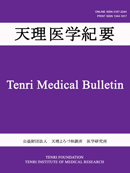Volume 18, Issue 1
Displaying 1-6 of 6 articles from this issue
- |<
- <
- 1
- >
- >|
Special Article
-
Article type: Special Article
2015Volume 18Issue 1 Pages 1-16
Published: December 25, 2015
Released on J-STAGE: July 01, 2015
Download PDF (2028K)
Original Article
-
Article type: Original Article
2015Volume 18Issue 1 Pages 17-22
Published: 2015
Released on J-STAGE: July 01, 2015
Advance online publication: April 15, 2015Download PDF (1343K)
Case Report
-
Article type: Case Report
2015Volume 18Issue 1 Pages 23-30
Published: 2015
Released on J-STAGE: July 01, 2015
Download PDF (2153K) -
Article type: Case Report
2015Volume 18Issue 1 Pages 31-35
Published: December 25, 2015
Released on J-STAGE: July 01, 2015
Download PDF (826K)
Pictures at Bedside and Bench
-
Article type: Pictures at Bedside and Bench
2015Volume 18Issue 1 Pages 36-39
Published: December 25, 2015
Released on J-STAGE: July 01, 2015
Download PDF (1047K)
Letters to the Editor
-
Article type: Letters to the Editor
2015Volume 18Issue 1 Pages 40-41
Published: 2015
Released on J-STAGE: July 01, 2015
Download PDF (329K)
- |<
- <
- 1
- >
- >|
